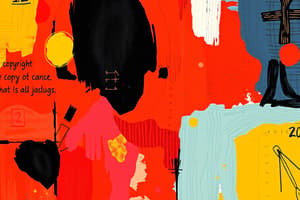Podcast
Questions and Answers
What is the primary purpose of copyright registration?
What is the primary purpose of copyright registration?
- To prevent unauthorized use of the work
- To grant exclusive rights to the author
- To establish a public record of the work
- To facilitate legal action against infringement (correct)
What is the typical duration of copyright protection?
What is the typical duration of copyright protection?
- A fixed period of 100 years
- A fixed period of 50 years
- The life of the author plus 70 years (correct)
- The life of the author plus 50 years
Which of the following is NOT a type of work protected by copyright?
Which of the following is NOT a type of work protected by copyright?
- Dramatic works
- Literary works
- Musical works
- Scientific discoveries (correct)
What is the term for the exclusive right to reproduce a copyrighted work?
What is the term for the exclusive right to reproduce a copyrighted work?
What is patent infringement?
What is patent infringement?
Which of the following is a consequence of patent infringement?
Which of the following is a consequence of patent infringement?
Flashcards are hidden until you start studying
Study Notes
Copyright Protection
- Definition: Copyright protects original literary, dramatic, musical, and artistic works, such as books, music, and films.
- Types of works protected:
- Literary works: novels, poems, plays
- Musical works: melodies, compositions
- Artistic works: paintings, sculptures, photographs
- Dramatic works: movies, TV shows
- Rights granted:
- Reproduction right: exclusive right to reproduce the work
- Distribution right: exclusive right to distribute copies of the work
- Display right: exclusive right to display the work publicly
- Performance right: exclusive right to perform the work publicly
- Duration: Typically, the life of the author plus a certain number of years (e.g., 70 years in the US)
- Registration: Not required, but recommended to establish proof of ownership and facilitate legal action
Patent Infringement
- Definition: Patent infringement occurs when someone makes, uses, sells, or offers to sell an invention without the patent owner's permission.
- Types of infringement:
- Direct infringement: making, using, or selling a patented invention without permission
- Indirect infringement: inducing or contributing to the infringement of a patent
- Defenses:
- Patent invalidity: the patent is invalid due to a lack of novelty, non-obviousness, or other reasons
- Patent misuse: the patent owner is using the patent in a way that is contrary to public policy
- Remedies:
- Injunctions: court orders to stop the infringing activity
- Damages: monetary compensation for losses suffered due to infringement
- Attorney fees: reimbursement of legal fees incurred in pursuing the infringement claim
Copyright Protection
- Original literary, dramatic, musical, and artistic works are protected by copyright, including books, music, and films.
- Four types of works are protected: literary, musical, artistic, and dramatic works.
- Examples of literary works include novels, poems, and plays.
- Examples of musical works include melodies and compositions.
- Examples of artistic works include paintings, sculptures, and photographs.
- Examples of dramatic works include movies and TV shows.
- Copyright grants five exclusive rights to the creator: reproduction, distribution, display, performance, and adaptation.
- The duration of copyright protection typically lasts for the life of the author plus a certain number of years (e.g., 70 years in the US).
- Registration is not required, but it is recommended to establish proof of ownership and facilitate legal action.
Patent Infringement
- Patent infringement occurs when someone makes, uses, sells, or offers to sell an invention without the patent owner's permission.
- There are two types of patent infringement: direct and indirect infringement.
- Direct infringement involves making, using, or selling a patented invention without permission.
- Indirect infringement involves inducing or contributing to the infringement of a patent.
- Two common defenses against patent infringement are patent invalidity and patent misuse.
- Patent invalidity claims that the patent is invalid due to a lack of novelty, non-obviousness, or other reasons.
- Patent misuse claims that the patent owner is using the patent in a way that is contrary to public policy.
- Remedies for patent infringement include injunctions, damages, and attorney fees.
- Injunctions are court orders to stop the infringing activity.
- Damages provide monetary compensation for losses suffered due to infringement.
- Attorney fees reimburse legal fees incurred in pursuing the infringement claim.
Studying That Suits You
Use AI to generate personalized quizzes and flashcards to suit your learning preferences.




